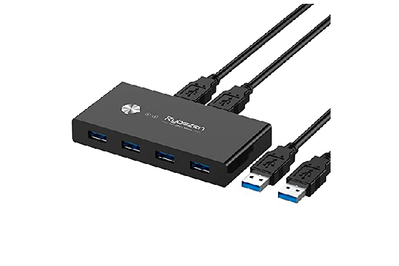I’m neurotic about my desk house. I can’t work except my house is totally clear and arranged, and I’ve spent an unconscionable period of time beneath my desk like a mechanic beneath a hood, meticulously hiding unfastened cables. However even in spite of everything that work, I used to be usually annoyed by the tedious dance of plugging and unplugging all of my peripherals each time I needed to change between my work and private computer systems. So I began on the lookout for methods to simplify the swap between two computer systems sharing the identical monitor, and fortunately, I discovered KVM switches.
A KVM (keyboard, video, and mouse) change permits you to plug a number of computer systems and peripherals into one hub and, with the press of a button, change backwards and forwards between the computer systems with out having to maneuver or rewire something. Some monitors and keyboards have built-in KVM switches, but when yours don’t, yow will discover a ton of choices for hubs that vary in value and measurement. I drifted towards the cheaper finish of the spectrum as a result of I first needed to see if a KVM change would clear up my drawback earlier than springing for a dearer model with extra options. It’s been over a yr since I bought the $20 Rybozen 4-Port USB 3.0 Switch, and that mannequin has labored completely—I haven’t wanted to improve.
Earlier than shopping for a KVM change, I took inventory of which peripherals I used regularly: a USB microphone, an external webcam, and a wireless mouse and keyboard that every join by means of a USB-A dongle. So I seemed for a KVM change that had no less than 4 USB-A ports.
Ideally, I needed a change that will additionally swap my monitor enter routinely. However as a result of I join my computer systems to my monitor utilizing each DisplayPort and HDMI—a function out there solely in dearer KVM switches—I made a decision I might stay with altering the enter on my monitor manually. For me, this small annoyance was well worth the distinction between a $20 KVM change and a $200 mannequin.
In my preliminary analysis, I used to be involved about latency affecting my peripherals, and I bought particularly into the weeds after I thought-about the switches that supplied video output. However I discovered that I, like most individuals, don’t want to fret about that. I discovered that except you play video games competitively on-line, or if in case you have a pleasant PC gaming rig and also you need particular decision and refresh-rate assist, you aren’t more likely to discover any issues with lag—even with a less expensive KVM change.
Establishing the KVM change was a breeze. The Rybozen change got here with two USB cables out of the field, which I used to attach every of my computer systems to the again of the hub. By the 4 USB ports within the entrance, I linked my peripherals. For additional peace of thoughts, I additionally connected the change to the underside of my desk utilizing double-sided Velcro to maintain it, and any wires working to it, out of sight.
And that was it—now, with each computer systems turned on, a easy press of the button on the KVM change seamlessly pairs my peripherals with one or the opposite in lower than a second. The one factor I’ve to do to transition between my work and private computer systems is manually choose the enter on my monitor and press a button on the KVM change. With a desk freed from litter and no units to fuss with, I can lastly work with out distraction—effectively, with out that distraction, anyway.
This text was edited by Kimber Streams and Annemarie Conte.


